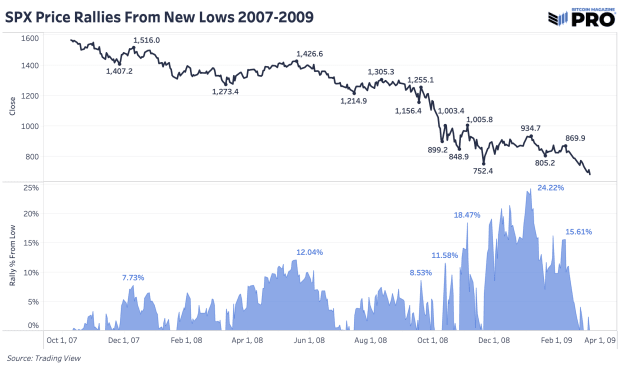Volatility thrives in market uncertainty and comes out the most in bear markets. It helps to examine the volatility conditions throughout past cycles.
The below is an excerpt from a recent edition of Bitcoin Magazine Pro, Bitcoin Magazine’s premium markets newsletter. To be among the first to receive these insights and other on-chain bitcoin market analysis straight to your inbox, subscribe now.
Word Of The Day: Volatility
Are you prepared for increased volatility? It’s common for markets to only get more volatile as we go deeper into bear markets. As uncertainty, illiquidity and impatience grows, more market participants start to hope for market extremes: either that the market has bottomed and a new bull cycle is one Federal Reserve pivot away or that the limit down, margin call liquidation day will happen imminently because of a Credit Suisse collapse. Everyone hangs on the edge with each major market move to give them some sort of signal. Price ranges start to widen and some (would-be) weekly or monthly moves are condensed into just a single day of action.
Even arguably one of the best investors of all time, Stanley Druckenmiller, finds today to be one of the hardest environments to figure out:
“I have been doing this for 45 years and between the pandemic, the war and the crazy policy response in the U.S. and worldwide, this is the hardest environment I have ever encountered to try and have any confidence in a forecast six to twelve months ahead.”
For most, it’s best to sit out the action and have a large risk-off position, ready to deploy after markets have stabilized or calmed down.
We still hold our same view that new lows are likely to be made and that we’ve yet to reach a final conclusion yet to the cycle for equities, risk assets and bitcoin.
We will remind readers of the magnitude of bear market rallies that we’ve seen so far and the magnitude of these rallies in 2000 and 2008 analogues. There are other cycles to study and compare but these are just a few recent examples.
We’ve already seen a significant 17.41% rally from lows for the SPX with bitcoin running to $25,000. Yet, that didn’t change its next reversion lower and, what we think, is the medium-term downside trajectory playing out still. Even in the last-stage collapses of 2002 and 2009, the S&P 500 saw rallies over 20% before going lower. As the market piles in to overshort bloody conditions and doomsday news on higher leverage, remember that there’s no free lunch.



Another interesting point to note is that bear markets are typically short, lasting 10 months on average. That 10-month benchmark would roughly put us to where we are today. Yet, there’s a useful idea and thesis to be made that the current destruction we’ve seen so far has been about the readjustment to a unique and historic time for rates, bonds and credit. We’ve barely even arrived at what is the classic and cyclical earnings bear market.
As bonds, currencies, and global equities all have continued trading with increasing levels of volatility, the recent historical and implied volatility of bitcoin is eerily muted compared to historical standards.
While the lack of recent volatility in bitcoin could be a sign that much of the leverage and speculative mania of the bull market has been almost entirely washed out, our eyes remain on the outsized legacy markets for signs of fragility and volatility, which could serve as a short/intermediate-term headwind.
While the world around bitcoin’s price action looks to be becoming increasingly uncertain, the Bitcoin network remains completely unaffected at the protocol level, continuing to do its job as a neutral monetary asset/settlement layer, despite its exchange rate volatility.
Tick tock, next block.
Relevant Past Articles
- 2/23/22 – What The Hell Is Going On With Financial Markets
- 6/6/22 – Equities Bear Market Unfolding
- 7/11/22 – When WIll The Bear Market End?
- 9/1/22 – Inflationary Bear Market Spells Trouble For Investors





